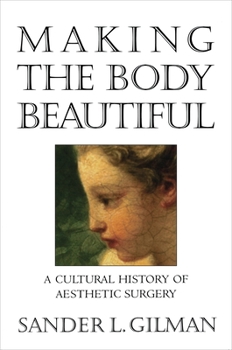Making the Body Beautiful: A Cultural History of Aesthetic Surgery
Select Format
Select Condition 
Book Overview
Nose reconstructions have been common in India for centuries. South Korea, Brazil, and Israel have become international centers for procedures ranging from eyelid restructuring to buttock lifts and tummy tucks. Argentina has the highest rate of silicone implants in the world. Around the globe, aesthetic surgery has become a cultural and medical fixture. Sander Gilman seeks to explain why by presenting the first systematic world history and cultural theory of aesthetic surgery. Touching on subjects as diverse as getting a "nose job" as a sweet-sixteen birthday present and the removal of male breasts in seventh-century Alexandria, Gilman argues that aesthetic surgery has such universal appeal because it helps people to "pass," to be seen as a member of a group with which they want to or need to identify. Gilman begins by addressing basic questions about the history of aesthetic surgery. What surgical procedures have been performed? Which are considered aesthetic and why? Who are the patients? What is the place of aesthetic surgery in modern culture? He then turns his attention to that focus of countless human anxieties: the nose. Gilman discusses how people have reshaped their noses to repair the ravages of war and disease (principally syphilis), to match prevailing ideas of beauty, and to avoid association with negative images of the "Jew," the "Irish," the "Oriental," or the "Black." He examines how we have used aesthetic surgery on almost every conceivable part of the body to try to pass as younger, stronger, thinner, and more erotic. Gilman also explores some of the extremes of surgery as personal transformation, discussing transgender surgery, adult circumcision and foreskin restoration, the enhancement of dueling scars, and even a performance artist who had herself altered to resemble the Mona Lisa. The book draws on an extraordinary range of sources. Gilman is as comfortable discussing Nietzsche, Yeats, and Darwin as he is grisly medical details, Michael Jackson, and Barbra Streisand's decision to keep her own nose. The book contains dozens of arresting images of people before, during, and after surgery. This is a profound, provocative, and engaging study of how humans have sought to change their lives by transforming their bodies.
Format:Hardcover
Language:English
ISBN:0691026726
ISBN13:9780691026725
Release Date:April 1999
Publisher:Princeton University Press
Length:424 Pages
Weight:1.30 lbs.
Dimensions:1.2" x 6.0" x 9.0"
Customer Reviews
2 ratings
The Sociology of Surgery
Published by Thriftbooks.com User , 15 years ago
Sander Gilman has delivered an intellectual tour de force in his book Making The Body Beautifu: A cultural history of aesthetic surgery. In nine chapters he covers such fields as the rise and development of surgery, how surgery designed to specifically alter appearance rather than fight disease or stave off death, became not only possible, but socially acceptable; the racial and cultural drivers that underpinned demand for such procedures as otoplasty ( pinning back ears) and rhinoplasty (reshaping noses); and the rise of the social cult of the body erotic, the body beautiful and the war on aging. He explores the impact of the mutilating injuries of the great war on the development of surgery and he deals with the issues around trans-gender dysphoria and surgery designed to alter the outward sexuality of the human body. His research is detailed and impeccable and his writing easy to read. This book is a "must-have" text for anyone interested in the two-way interaction between between Society at large and the microcosm of surgical intervention. It is both a useful reference for the academic or surgeon and a fascinating read for the interested layman.
Hardly Dead
Published by Thriftbooks.com User , 21 years ago
The other critic seems to suggest that historical research has no value--only the voices of the present are of use to him. His loss--Gilman is an amazing historian and insightful interpreter of social customs and texts--and there is much to be learned from any book he writes.





